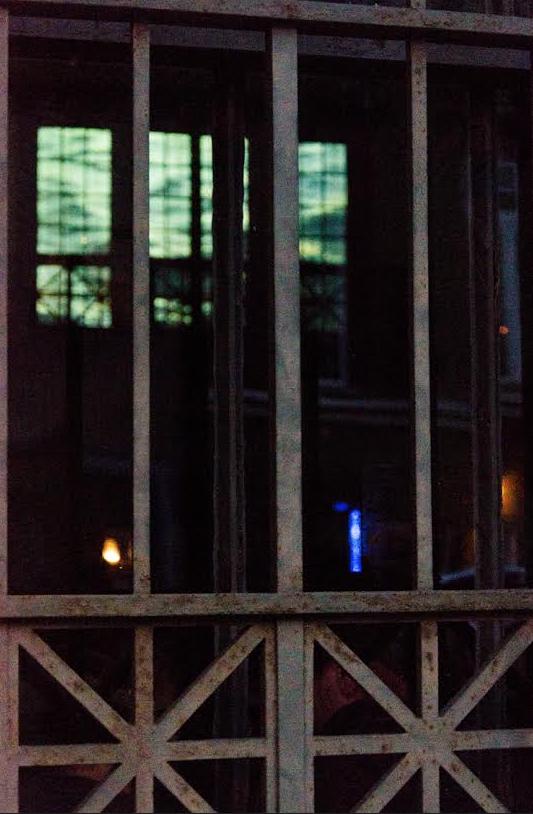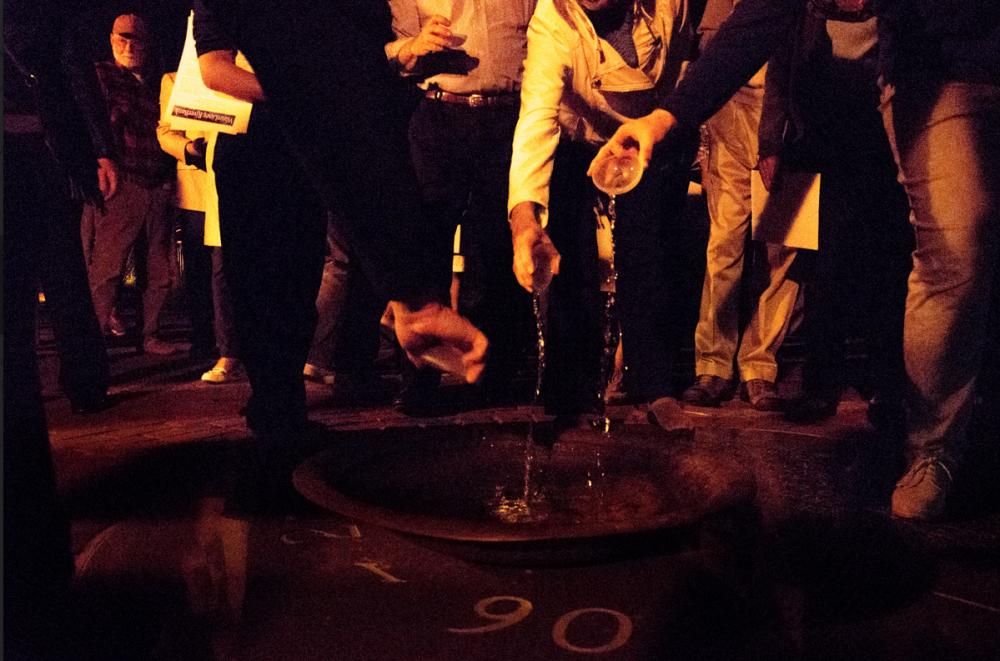Last Wednesday, Thursday, and Friday, something extraordinary happened in the vacant Chestertown Bank building. As darkness fell each evening, a watery, bluish glow emanated from the double glass doors set into its dignified Neo-Classical façade. Inside, the familiar, staid lobby had become a world of rippling light and sublimely meditative sound.
 Sometimes it takes a stranger to show you what you have. In this case, it was four strangers: architect and installation artist Ronit Eisenbach, dance artist and choreographer Cassie Meador, composer Aleksandra Vrebalov, and biologist and visual artist Jenifer Wightman. Invited to Washington College by the Sandbox Initiative, these interdisciplinary visiting artists have spent this academic year getting to know the area, its environment, community, and history. Along the way, they gathered information and insight from many local sources, along with videos, with the help of Seane Meador, and sound recordings, all of which led to “WaterLines: RiverBank.”
Sometimes it takes a stranger to show you what you have. In this case, it was four strangers: architect and installation artist Ronit Eisenbach, dance artist and choreographer Cassie Meador, composer Aleksandra Vrebalov, and biologist and visual artist Jenifer Wightman. Invited to Washington College by the Sandbox Initiative, these interdisciplinary visiting artists have spent this academic year getting to know the area, its environment, community, and history. Along the way, they gathered information and insight from many local sources, along with videos, with the help of Seane Meador, and sound recordings, all of which led to “WaterLines: RiverBank.”
Involving members of the community throughout, the three-day event included the multimedia installation in Chestertown Bank and a dance performance on Thursday evening, preceded by a morning gathering at the foot of High Street to collect water to be used in the performance. Although I missed the performance due to a prior commitment, experiencing just the installation in the bank was unforgettable.
Its darkened lobby, strangely stripped bare of the tellers’ counters and desks, was filled with a shifting tapestry of light and sound. Tinkling bells and wind chimes wove in and out along with the sound of a ship’s horn and the muffled calls of ducks and herons as something akin to the singing of souls came cascading from all around. Spilling high across two walls, videos of light flickering on the Chester River’s gentle waves were projected through a tall side window and through the gauze curtains of the 2nd story French doors overlooking the lobby.
Another video streamed across the tiled floor, its patterns of earthy color sweeping forward like waves rolling up the shore, then turning slightly sideways to wash back. Although the rhythmic motion brilliantly captured the calming, hypnotic movement of lapping waves, the images were not of water but instead showed a time-lapse sequence of Wightman’s mud paintings, multicolored panels of Chester River mud on view at the Sandbox gallery since February. The organic abstractions created by live microorganisms in the mud have been slowly changing as colors bloom and fade with the growth and decay of the minute organisms.
Whether or not you know the story behind the mud paintings, the evolving sequence was inspired. Although the video documented the interconnecting life cycles of microbes, it just as easily called to mind the forming and dissolution of galaxies. Either on a microscopic or cosmic scale, what mattered was that you were seeing nature at work, creating, evolving, transforming.
Skimming over the tile of the floor, the organic imagery made a distinct contrast with its setting in the orderly, institutional building. A bank is meant to be a stable, trustworthy place. Siting “Waterlines” in a bank that has gone out of business conjured the uneasy feeling that there is nothing whose permanence can ultimately be relied on. Given the watery reflections shimmering in every direction, there was even a feeling that this might be how the building itself will look in a few centuries if sea level rise continues unchecked.
 The inevitability of change was underscored by stepping into the bank’s open vault. The rows of safety deposit boxes were in disarray, some of their doors locked, some left ajar. Instead of deeds and precious family jewelry, some held small bowls of river water or tiny videos, all shot locally, pointedly inferring that these things may well be even more valuable.
The inevitability of change was underscored by stepping into the bank’s open vault. The rows of safety deposit boxes were in disarray, some of their doors locked, some left ajar. Instead of deeds and precious family jewelry, some held small bowls of river water or tiny videos, all shot locally, pointedly inferring that these things may well be even more valuable.
The videos presented familiar scenes of Chestertown’s waterfront geese and ducks and its docks, drainage pipes and marshes, the banding and release of birds at the college’s Foreman’s Branch Bird Observatory, the dreamy underwater movement of swimmers, and close-ups of gesturing hands shot while the artists were interviewing community members. In the intimate space of the cramped vault, these modest, local subjects were brought into sharp focus, provoking thoughts about their significance and how they too are changing.
For those of us who have lived in this area for many years, “WaterLines” was saturated with memory and love—memory of the buildings, businesses, people and seasons that have come and gone, and love for the river and its marshes, shorebirds, shifting tides, and halcyon days of sunlight on the water. Such feelings are warm and joyful but also fraught with anxiety as the ecological challenges to our beloved home become more obvious.
In the ever-shifting, contemplative space created by this installation, the mind quieted and breathing took on the measured cadence of the phantom shimmering waves. Gradually, the flow of light and sound began to feel curiously more real and authentic than the everyday world of computers, phone calls, cars and schedules. Simultaneously, fear of change slowly gave way to a deeper understanding that what we are called on to do is to welcome and acknowledge change and use our innate creativity to adapt to its gifts and challenges.
Photo credit – Zachary Z. Handler
..



Write a Letter to the Editor on this Article
We encourage readers to offer their point of view on this article by submitting the following form. Editing is sometimes necessary and is done at the discretion of the editorial staff.